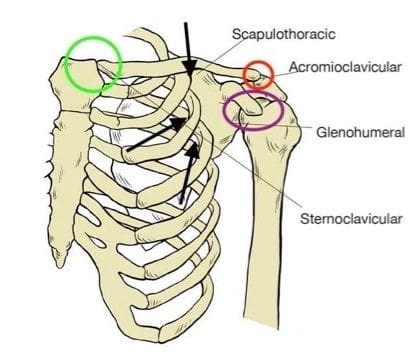
Bulletproof Shoulder
October 5, 2020|Back Pain, Neck Pain, Posture, Shoulder Injuries
Shoulder pain, weakness and limited mobility (frozen shoulder) are some of the most common complaints we see in a Physical Therapy clinic. Shoulder pain can stem from a variety of different causes but encorpirationing a few exercises into your routine will increase the stability and strength of the shoulder and significantly decrease your likelihood of shoulder pain or injury. In this blog post we will discuss shoulder anatomy, exercises and physical therapy interventions.
Anatomy
Your shoulder is made of four separate joints: the sternoclavicular joint (SC-green circle), acromioclavicular joint (AC-red circle) , the glenohumeral joint (most motion in the body-purple circle), and the scapulothoracic joint (shoulder blade on rib cage-black arrows). The four joints of the shoulder complex need to work in unison for your shoulder to function properly.

- The rotator cuff is made up of 4 muscles: the supraspinatus, Infraspinatus, Teres minor and the Subscapularis. The rotator cuff muscles are important in shoulder movements and maintaining shoulder joint stability. The most common injury of the rotator cuff is a tear of the supraspinatus tendon (rotator cuff pain, rotator cuff tendonitis or tear)
- The scapular muscles (muscles around the shoulder blade) are also important for stabilizing the shoulder and they include: serratus anterior, upper/middle/lower trapezius, and levator scapula. These muscles help with proper posture and are often ignored in strengthening programs.
- Your shoulder, neck and thoracic spine are highly connected, so when you are working on improving your shoulder health, you have to consider your upper back and neck as well.
- The dance between the joints of your shoulder while lifting your arm over your head happens in a predictable fashion called “Scapular rhythm”. Scapular rhythm refers to how the scapula (shoulder blade) moves in relation to your glenohumeral joint. Normal scapular rhythm is 1:2 ratio, 1 degree of scapula upwards rotation to 2 degrees of humerus in the glenohumeral joint. The first 30 degrees of motion come purely from the glenohumeral joint (See picture below).

Exercises
- Scapular Y, T, W:
- These exercises help strengthen your scapular stabilizing muscles that keep your shoulder blade in place and normalize scapular rhythm by keeping the shoulder blade in the correct position, while also improving your posture
- Tips: Relax your upper trap and squeeze your shoulder blades now and together.
2. Serratus Anterior Strengthening:
- Serratus Anterior is your “punching muscle”, it helps push your extended arm further ways from your body (protraction). It also helps keep your shoulder blade flush to your thoracic cage and is very important in maintaining proper scapular rhythm.
- When Serratus anterior is very weak or does not engage properly, starting with a simple light weight exercise is indicated, but, as you progress, you want to make sure you are challenging yourself properly. Adding weight bearing variations use minimal equipment and are very effective.
3. Shoulder internal and external rotation:
- Internal Rotation (IR) and External Rotation (ER) are important movements to strengthen in multiple planes of motion. Your rotator cuff is responsible for internal and external rotation of your arm. These also help maintain proper positioning in the glenohumeral joint and help with stabilizing your shoulder.
- Tips:
- Keep the upper arm stable, if you are unable to control shoulder in variation you are attempting, modify so that you are successful
- Core muscles are engaged! Keep ribs tucked in and belly button drawn in towards your spine.
Physical Therapy Intervention
Physical Therapy is a useful tool when treating shoulder pain, weakness and/or mobility issues. If a shoulder has mobility issues that can’t be improved with just exercise a physical therapist can help with joint mobilizations, soft tissue mobilization, manual stretching, muscle re-education and dry needling. Physical Therapists are also experts on exercise, they assess proper muscle engagement and target the appropriate muscles to strengthen and stretch. If treated early, a shoulder deficit may only take weeks to heal as opposed to months if it’s ignored. Dynamic Physical Therapy spends an hour with each patient with a 1 on 1 session to ensure the best care and a speedy recovery.
If you are experiencing a shoulder dysfunction, Physical Therapy can help. Please contact us at Dynamic Physical Therapy – Chicago and follow us on Instagram and Facebook!
Please call (312) 643-1555 or email info@dynamic-PT.com with any questions or to schedule your consultation today.
